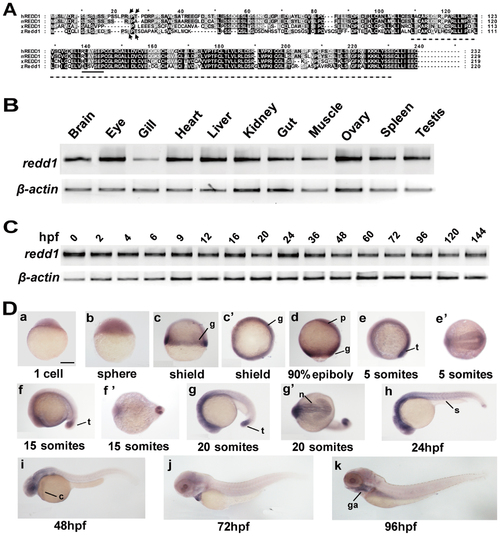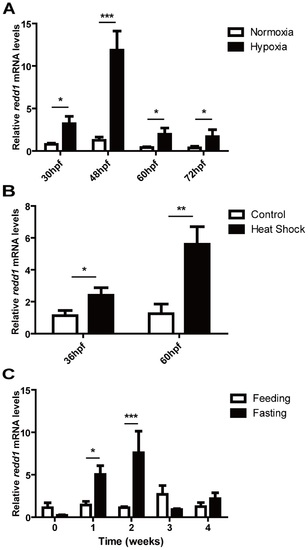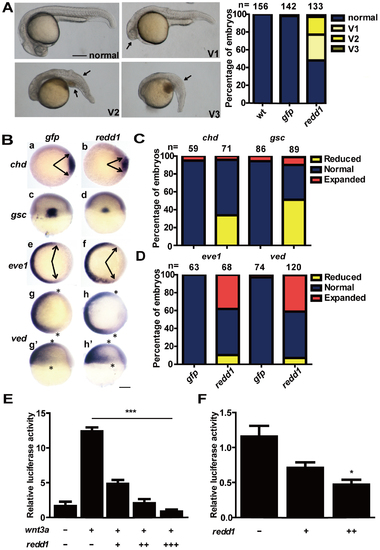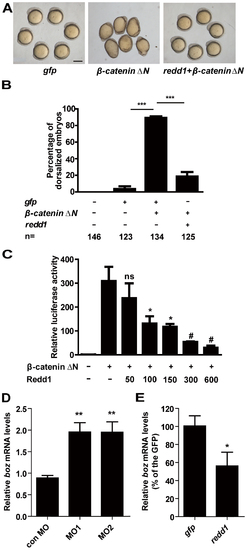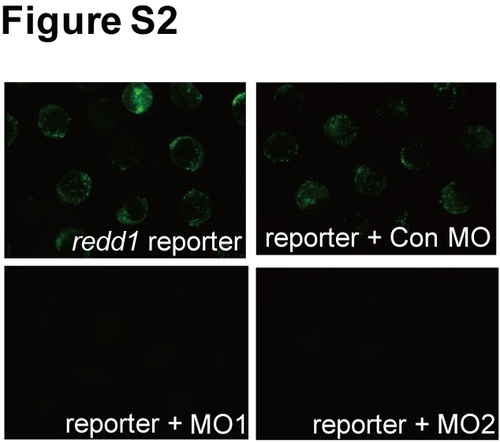- Title
-
The Stress-Response Gene redd1 Regulates Dorsoventral Patterning by Antagonizing Wnt/β-catenin Activity in Zebrafish
- Authors
- Feng, Q., Zou, X., Lu, L., Li, Y., Liu, Y., Zhou, J., and Duan, C.
- Source
- Full text @ PLoS One
|
Zebrafish redd1 encodes a conserved protein and is expressed in many tissues. A) Alignment of REDD1/Redd1 sequence from human, mouse, Xenopus, and zebrafish. Conserved residues are shaded. The RTP801_C domain is marked by a dotted line. Arrows mark the two Thr residues critical for human REDD1 phosphorylation and degradation. The conserved 14-3-3 binding site is indicated by a solid line. B) RT-PCR analysis of the indicated adult tissues. C) RT-PCR analysis of zebrafish embryos at the indicated stages. hpf, hours post fertilization. D) Whole mount in situ hybridization analysis of zebrafish embryos at the indicated stages. (a–c, d) Lateral views with the animal pole oriented at the top; (c2) Top view from the animal pole. (e, f, g, h–k) Lateral views with the anterior oriented toward the left. (e2, f2, g2) Ventral views with the anterior oriented toward the left. c, common cardinal vein; g, germ ring; ga, gill arches; n, neural ectoderm; p, prechordal plate/mesoderm; s, somite; t, tail bud. Scale bar = 200 µm. |
|
Zebrafish redd1 is a stress-response gene. A) Effect of hypoxia. 6, 24, 36, and 48 hpf old embryos were subjected to 24 h hypoxia treatment (10% of ambient O2 levels). Total RNA was isolated at the indicated developmental stages. The levels of redd1 mRNA were measured by qRT-PCR and normalized by the β-actin mRNA levels. In this and all subsequent figures, the mRNA levels are expressed as a relative value of the control group. Values are means ± S.E. (n = 3). * P<0.05, ** P<0.01, and *** P<0.001. B) Effect of heat shock. Embryos were subjected to 1 h heat shock (37°C) treatment in every 12 h and sampled at 36 hpf and 60 hpf. The levels of redd1 mRNA were measured as described above. C) Effect of food deprivation. Total RNA was isolated from juvenile fish with constant feeding (Feeding) or fasting (Fasting) at indicated time points. The levels of redd1 mRNA were measured and presented as described above. EXPRESSION / LABELING:
|
|
Knockdown of redd1 results in dorsalized embryos. A) Effects of redd1 knockdown. Upper panels are representative views of zebrafish embryos (at 5 somite stage) injected with control MO, redd1 targeting MO (MO1 or MO2), or redd1 targeting MO+ redd1 mRNA (MO+mRNA). Lateral views with anterior up. Scale bar = 200 µm. The results are from three independent experiments and the total embryo number is given at the top. B) Effects of redd1 knockdown. The experimental groups are the same as in A). Representative images of 24 hpf zebrafish embryos are shown in the upper panel. Scale bar = 200 µm. The percentage of dorsalized embryos in each group is shown in the lower panel. The total number of embryos is shown on the top of each column. C–G) Effects of redd1 knockdown on the expression of dorsoventral marker genes. Embryos described in A) and B) were analyzed by in situ hybridization using the indicated probes. Representative images are shown in C). Panels a–d and i–p are animal pole views with dorsal to the right; panels e–h are dorsal views with animal pole up; panels m2–p2 are lateral views with dorsal to the right and animal pole up. Arrows indicate the edges of the chd and eve1 mRNA expression domains. Asterisks indicate the edges of the ved mRNA expression domain. Scale bar = 200 µm. The percentage of embryos in each category is shown in D (chd), E (gsc), F (eve1), and G (ved). The results are from three independent experiments and the total embryo number is given at the top. PHENOTYPE:
|
|
Redd1 ventralizes embryos and inhibits Wnt signaling. A) Left panel: classification of phenotypes embryos caused by forced expression of Redd1. 1–2 cell stage embryos were injected with redd1 mRNA. They were raised to 24 hpf and examined. The percentage of embryos in each category is shown in the right panel. B–D) Effects of Redd1 expression. Embryos described in A) were analyzed by whole mount in situ hybridization using the indicated probes. Representative images are shown in B). Panels a–b and e–h are animal pole views with dorsal to the right; panels c–d are dorsal views with animal pole up; panels g2–h2 are lateral views with dorsal to the right and animal pole up. Arrows indicate the edges of the chd and eve1 mRNA expression domains. Asterisks indicate the edges of the ved mRNA expression domain. Scale bar = 200 µm. The percentage of embryos in each category is calculated and shown in C) (chd and gsc) and D) (eve1 and ved). The results are from three independent experiments and the total embryo number is given at the top. E) Redd1 inhibits Wnt3a activity. One-cell stage embryos were injected with 20 pg wnt3a mRNA alone or co-injected with 10 pg (+), 50 pg (++), or 100 pg (+++) redd1 mRNA. TCF/LEF-luciferase reporter DNA was injected in all groups. The embryos were raised to the shield stage and the luciferase activity was determined. Values are means ± S.E. (n = 3). *** P<0.001. F) Redd1 inhibits endogenous Wnt signaling. Embryos were injected with TCF/LEF-luciferase reporter DNA without and with 10 pg (+) or 100 pg (++) redd1 mRNA. The embryos were raised to the shield stage and the luciferase activity was measured. Values are means ± S.E. (n = 3). * P<0.05 compared to the TCF/LEF control group. |
|
Redd1 inhibits β-catenin action. A and B) Redd1 inhibits β-catenin action in vivo. Representative view of gfp mRNA-, β-catenin ”N mRNA-, and β-catenin ΔN mRNA + redd1 mRNA-injected embryos at 5 somite stage is shown in A). Scale bar = 200 µm. Quantitative results are shown in B). The results are from three independent experiments and the total embryo number is given at the bottom. *** P<0.001. C) Redd1 inhibits β-catenin activity in vitro. HEK293T cells were transfected with β-catenin ΔN plasmid DNA and increasing doses of Redd1 plasmid DNA, together with the same amount of TCF/LEF-luciferase reporter DNA. Cells transfected with TCF/LEF-luciferase reporter DNA alone were used as negative control ().Values are means ± S.E., n = 3. ns, not significant, * and #, P<0.05 and P<0.001 compared to the β-catenin ΔN group. D) Redd1 knockdown increases boz expression. Embryos were injected with control MO, redd1 targeting MO1 or MO2 at one-cell stage. The embryos were raised to the dome stage. The boz mRNA levels were measured by quantitative real-time RT-PCR. E) Forced expression of Redd1 decreases boz expression. Embryos were injected with gfp mRNA or redd1 mRNA at one-cell stage and were analyzed at dome stage. The boz mRNA levels were measured by quantitative real-time RT-PCR. |
|
The efficacy of redd1 MOs. A GFP reporter was constructed containing the entire 52-UTR and partial ORF of redd1. Embryos were injected with the GFP reporter DNA, reporter DNA + Control MO, reporter DNA + redd1 targeting MO1, or reporter DNA + redd1 targeting MO2. The injected embryos were raised to tail bud stage and photographed under a fluorescence microscope. |
|
Phenotypes of zebrafish redd1 MO injected embryos. Embryos were injected with redd1 targeting MO1 or MO2 at 1-cell stage and raised to 24 hpf. Lateral views are shown with the anterior oriented toward the left. The percentage of embryos with the indicated phenotype and the total number of embryos examined are shown in the right corner. Scale bar = 200 �m. |

